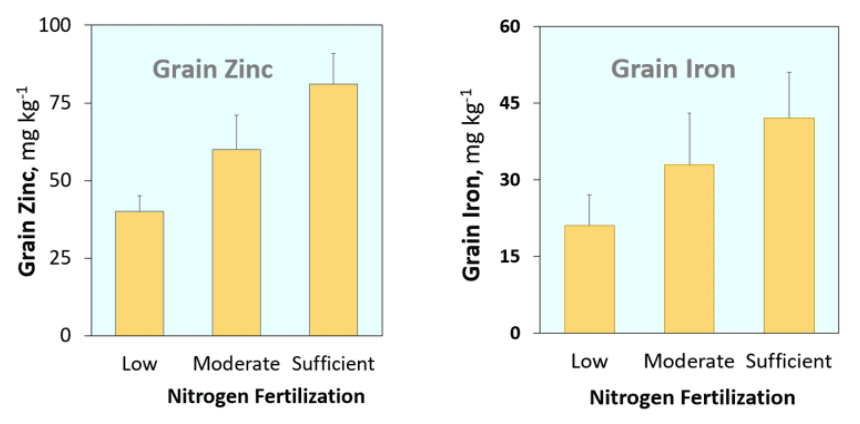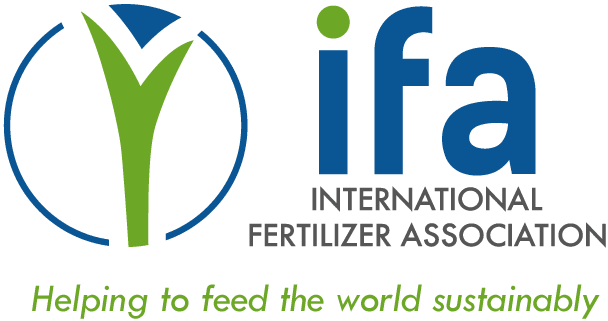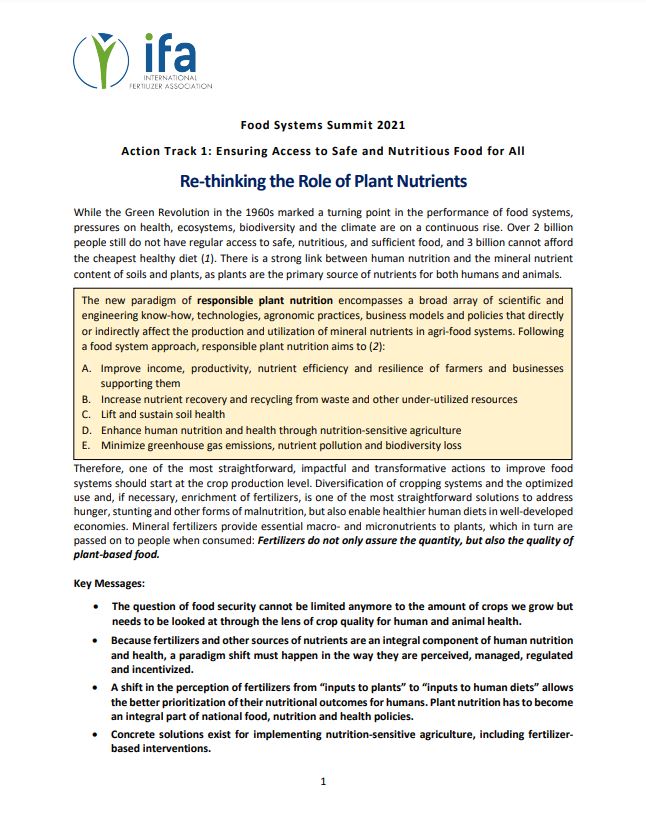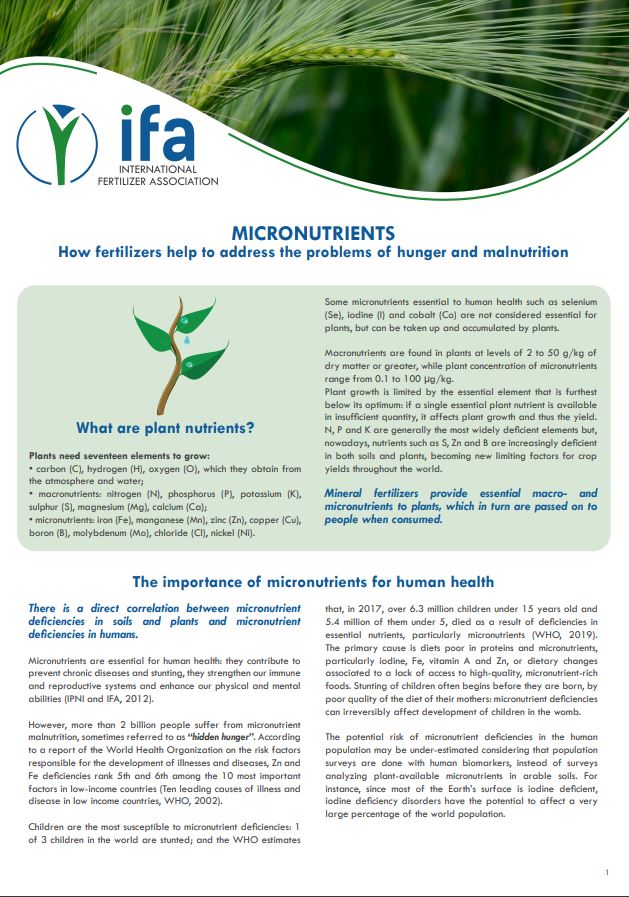Human Nutrition
about fertilizers
Changing our thinking: better plant nutrition for healthier diets.
Plant nutrients are much more than agricultural inputs: by growing crops for human and animal consumption they help provide essential calories, proteins, vitamins, minerals, dietary fiber, antioxidants and other bioactive compounds of importance for human nutrition and health.
As a precondition for growth, health and the production of nutritious food, plants require 14 essential mineral nutrients in sufficient quantities.
Fertilizer programs implemented in the past mainly focused on improving soil fertility and crop yields to increase farm incomes, with the main emphasis given to nitrogen (N), phosphorus (P), potassium (K) and sulfur (S) fertilizers (i.e. macronutrients found in plants at levels of about 2 to 50 g/kg of dry matter). Less attention has been paid to nutritional outcomes for human health, despite the important links between plant nutrition, health and dietary intakes of nutrients which recent studies have highlighted. In the United States, for example, a constant decline in ratios of K fertilizer and removals in crops has led to a decline in dietary K intake in the US population and a rise of hypokalemia, a human illness caused by low levels of potassium in the blood serum. in 2011, 3.5 and 1.1 billion people were at risk of calcium (Ca) and zinc (Zn) deficiency respectively, due to inadequate dietary supply, mostly in Africa and Asia.
A handful of micronutrient-poor crops dominate the global food and feed chains and have often decreased crop diversity or displaced traditional crops such as pulses Owing to often insufficient micronutrient (i.e. nutrients that concentrate in plants at a range of 0.1 to 100 μg/kg) fertilization, the steady growth of crop yields in recent decades has compounded the problem by depleting micronutrient concentrations in grains and soils, although, thus far the benefits of increased yields to supply food for a growing population appear to outweigh such nutrient dilution effects. However, in sub-Saharan Africa, for example, significant relationships can be found between soil nutrients and child mortality, stunting, wasting and underweight.
Micronutrient deficiencies affect an estimated 2 billion people in the world. Iron (Fe), zinc (Zn), selenium (Se) and iodine (I) deficiencies are well-documented problems, affecting both human and animal health, and also impacting agricultural productivity. Yields can be affected by deficiencies that impair the physiological processes related to seed formation, synthesis and the distribution of carbohydrates, biological nitrogen fixation and plant resistance to biotic and abiotic diseases. Zinc deficiency is common in up to 50% of wheat-cultivated soils worldwide and large areas of agricultural soils are also deficient in iron. Most of the earth’s surface is iodine deficient. Soil selenium concentrations are dominated by climate–soil interactions, and climate change is likely to further increase the risk of Se-deficiencies. Livestock health, productivity and product quality directly depend on a balanced supply of micronutrients from crops fed to animals and pastures used for grazing.

Breaking down the silos: nutrition-sensitive agriculture.
Optimized nutrient management solutions must focus on the whole nutritional contribution of food crops: producing affordable and healthier food for everyone.
Food systems have become increasingly globalized and interdependent, and diets around the world can be expected to keep changing.
Nutrition-sensitive agriculture is a food-based approach to agricultural development that puts nutritionally rich foods, dietary diversity, and food fortification at the heart of overcoming malnutrition and micronutrient deficiencies. Making agriculture more nutritionsensitive requires a new way of thinking, planning, implementing, and partnering. Nutrition and health outcomes need to be systematically embedded in agricultural and other policies, including integration of education and extension programs targeting farmers and consumers. Promoting the diversification of production in the field, improved food processing, healthier diets, or other interventions along the supply chain requires good collaboration among the concerned sectors and actors.
Critical entry points where nutrition goals can be best incorporated into agri-food systems must be clearly identified. Nutrition-sensitive agricultural programs and policies will not be successful if the targeted nutrients are missing in soils and/or in the edible plant parts at desirable levels for animal and human nutrition. In Africa, for example, statistically significant relations can be found between soil nutrients and child mortality, stunting, wasting and underweight. Therefore, fertilizers – both mineral and organic fertilizers – play a key role in helping to sustainably diversify and intensify agricultural production and through that achieve better nutritional and health outcomes. At the same time, it is also vital that impurities in fertilizers do not adversely affect soil or food quality, with cadmium being the element requiring most careful management in mineral fertilizers.
The fertilizer industry therefore calls on governments to support nutrition-sensitive agriculture by:
Prioritizing a sustainable intensification and diversification of cropping systems
Prioritizing a sustainable intensification and diversification of cropping systems aiming to close existing yield gaps, produce high-quality, nutritious crops, and increase the nutritional output through better diversity of cropping systems and crops grown. The balanced supply of nutrients from fertilizers and other sources is a key requirement for that. This also supports changes in land use to respond to new market demands due to changing diets, provide nutritious food to local populations, address changing climatic conditions, improve biodiversity, or save water and other natural resources.
Promoting a targeted enrichment of local staple food crops with micronutrients where it is most needed
A broad and multi-intervention strategy should be put in place to lift up the basic supply of micronutrients and reach deep in the poorer-income segments of countries with lingering malnutrition problems.
Improving the health and wellbeing of livestock
Nutrient-rich pastures, grain and other feedstuff contribute to enhancing the biochemical richness of meat and dairy products, resulting in 4 increased nutrient availability to humans, and a better quality and shelf life of products, thus also reducing food waste.
Prioritizing agricultural policies to help farmers to change their land use and adapt to a new environmental, social and/or economic reality should be done in close cooperation with national health and environmental agencies. This allows to ensure a stronger end-to-end connectivity between farmers and consumers.
In the context of nutrition-sensitive agriculture, plant nutrients can be managed in a manner that focuses on crop requirements and exploits the interactions of mineral nutrients in soils and plants to achieve multiple economic, food security and nutrition outcomes. For example, an optimal nitrogen fertilization of crops will ensure high yield and protein content, but it also increases the concentration of micronutrients in plants’ grains:

Numerous studies have also shown that balanced fertilization, i.e. giving the proper supply of all macronutrients and micronutrients in a balanced ratio throughout the growth of crops, helps crops become more resilient to drought, heat, winds and storms, pests and diseases.
Hence, the key to success are well-tailored fertilizer best management practices that follow the 4Rs principles(20): using the right source of nutrients, at the right rate, at the right time and in the right place. Implementing the 4Rs has demonstrated that crop yield, quality and nutrient use efficiency are improved, while nutrient losses to the environment are minimized. Besides high-tech 4R solutions for commercial farming, “low-tech” site-specific nutrient management approaches have shown consistent, large increases in crop yields and profits and nutrient use efficiency in many crops grown by smallholder farmers in Asia and Africa. Particularly in sub-Saharan Africa, integrated soil fertility management (ISFM) approaches combine the use of mineral and organic nutrient sources with good soil management practices, cropping systems, choice of suitable crop varieties, and other agronomic practices.


